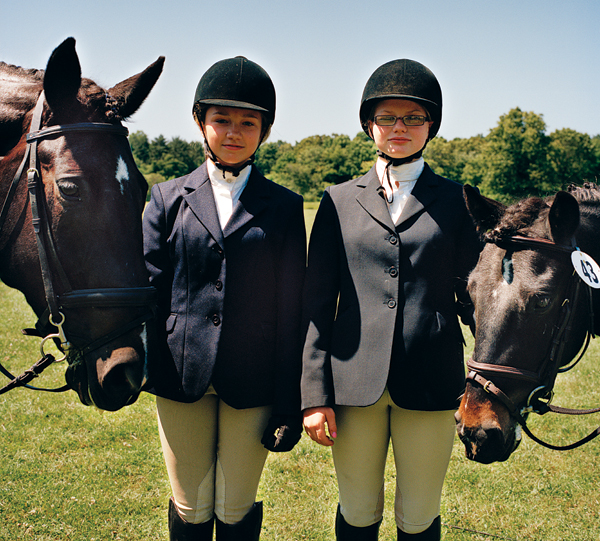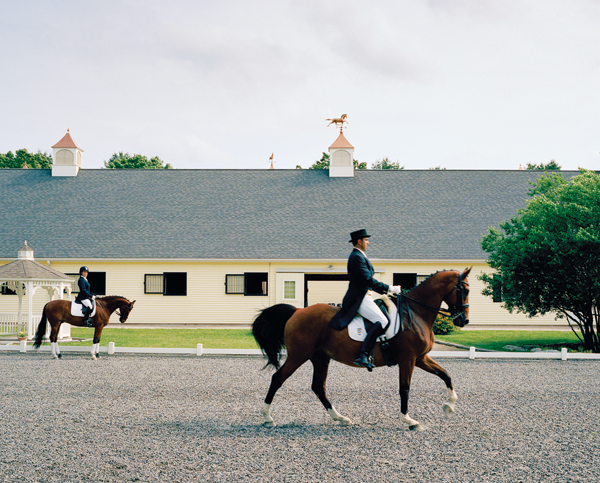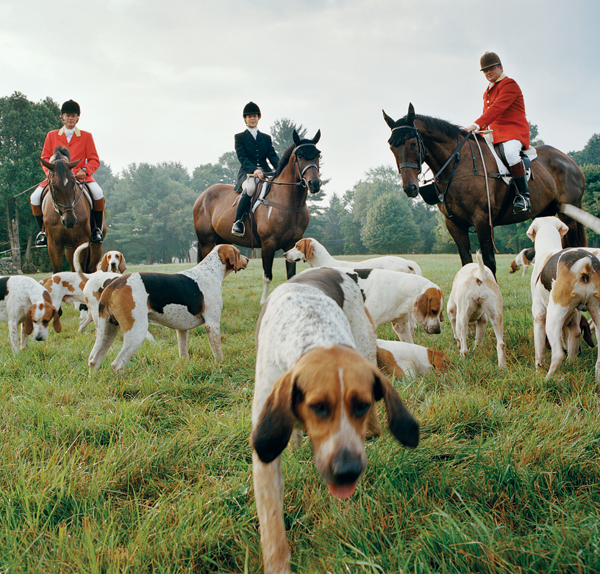All The Pretty Horses
Equestrian pursuits abound in Massachusetts, fueled by adoration for the steed and enough money to run a small country.

Members of the Myopia Hunt Club gather on the back lawn of Nick and Missy White’s South Hamilton estate. / Photo by Mark Hartman
What first possessed prehistoric man to sit astride a horse and wrestle the wild beast into submission? Did this outrageous act come after several spectacular failures, such as the saddling of the saber-toothed tiger or roping of the woolly mammoth? Perhaps, sizing up the horse, a brave individual concluded that its proportions were just right to carry him quickly over long distances, while its teeth were best suited to mashing carrots instead of limbs.
However that primordial ride transpired, the horse is today a highly specialized animal, bred almost exclusively for sport, which makes the warmbloods, thoroughbreds, and quarter horses seen on the money side of Massachusetts’ white-picket fences highly valued. And thanks to the Brahmins’ historically intense predilection for all things European, equestrian sports in this state are highly developed. The horse set will proudly remind you that the Myopia Club in Hamilton (founded by a Forbes) boasts the nation’s oldest continually used polo field, and that the U.S. Equestrian team once trained nearby. When the New England Dressage Association was established in 1972, it was the first organization of its kind in the nation, and it continues to be the country’s most robust chapter, with 1,800 members. The 117-year-old Norfolk Hunt, based in Dover, is also among the nation’s first hunt clubs, while equine-supply empires SmartPak and Dover Saddlery call Massachusetts home.

Donna Cameron, owner of Cutler Farm in Medfield,with her dressage trainer, Dave Thind. / Photo by Mark Hartman
But back to the horses themselves. Those who know nothing of the 1,500-pound animals in question typically admire their physiques from afar, but sniff at their apparent lack of intelligence. A smart horse, however, would be less than useless. What equestrians desire—whether the sport in question is dressage, polo, or hunting—is a hard-working, submissive equid that’s sensitive enough to interpret a few commands, either through the reins or from a shift of weight in the saddle. Getting a horse to respond correctly can take years, but the payoff is much grander than a fetched newspaper.
With their gazelle-like eyes positioned outward to detect predators, horses are high on anxiety, high on instinct, and low on analysis. They follow their gut (which usually tells them to obey those who feed them), and when they do, they sometimes find themselves in a dressage ring trussed with double reins and a pair of tight middle-aged buns in the saddle. The sport is performed entirely in a 66-by-197-foot arena, where the animals are asked to perform a series of profoundly unnatural acts. Dressage is easily the most evolved saddle sport—some would say the zenith of man-on-horse action—and the most expressive result of the many millennia we’ve spent training horses to do our bidding. The equine athletes prance high without moving forward (the piaffe), change gait mid-stride (the flying change), and circle in place (the pirouette). Witnessed for the first time, this balletic display elicits either gasps or giggles, but such equitation may have once served a purpose—in-place stomping, it’s said, was designed to finish off fallen foes on the battlefield.

Mornings are always busy at Cutler Farm, where there’s mucking to be done and horses to groom. / Photo by Mark Hartman

A horse’s mane is tightly braided for the Beland Stables Dressage Show in Lakeville. / Photo by Mark Hartman

Though not as adrenaline-packed as show jumping, dressage appeals to some younger riders. / Photo by Mark Hartman
Dressage tends to attract an older, predominantly female crowd, especially in Massachusetts, where women of a certain age and a certain income suddenly reconnect with horse fantasies of their youth but have no desire to depart from the ground for an extended length of time. Once entrenched, they commit approximately $35,000 per year (per horse) to their hobby. They hire a trainer to help find a suitable animal, which may involve a trip to Germany or the Netherlands, where the warmbloods are bred long up front and muscular in the back, a look that tends to show well. A quarter of a million dollars isn’t unheard of, and a highly trained 15-year-old (called a Grand Prix horse) can earn a neophyte dressage queen instant cred. Boarding these animals can cost $1,500 a month, especially if the barn is posh, has a Pilates studio, and is located near Boston. Then there are the acupuncturists, the vet, the animal communicators, the farriers, each at the ready to keep the mount in fine form.
Not every horse enjoys performing tricks before a silent judge. He’ll tolerate the saddle and submit to endless commands well enough, but when the stakes are high—when his mane is tightly braided, tail brushed (maybe with a few extensions to fill it out), $7,000 Hermès saddle on, rider atop in clean white breeches, shadbelly coat, and a rhinestone pin at the neck—the horse just may throw a tantrum.
Here’s what this looks like: He’ll buck a little during his first promenade around the arena. He’ll shy away when he approaches the judges’ trailer, rolling his eyes to reveal crescents of white. His nostrils will flare and his ears will jerk about frantically. With each tug of the rein or flick of the riding crop, he will shiver and snort indignantly. When they’ve seen enough of this, the judges will say, “Another day,” and the frustrated rider will turn the horse around and head out, with the animal still rearing at every directive, twitchy even as he’s led back by a harness to the trailer.

Outdoor dressage training is a rare but stunning event at Cutler Farm, as demonstrated by Dave Thind (aboard Nicardo) and Donna Cameron (aboard Leonardo da Vinci). / Photo by Mark Hartman
If you have any skill reading the physiognomy, you’ll recognize the worried look many dressage horses have—a slight wrinkling around the upper eye. Another common ailment among this group of quadrupeds: ulcers.
Then again, maybe the personality of that lovely steed, recently imported from Europe at great expense, is better suited for the hunt, an outing available at a handful of clubs scattered about Boston’s outer belt. Quite a different character of horse thrives here—one that enjoys the company of others and doesn’t mind the constant annoyance of the hounds and their incessant baying while they literally run circles around his hooves. For the focused horse who loves to lope across the countryside and take a jump or two along the way, this is heaven. Of course, there’s no fox. Instead, the canines follow a spicy scented trail—made of anise and other pungent compounds—pre-dragged 10 miles or so over hill and dale, and over fences and walls, too, to keep the hunt lively. What’s the point, then? Hunting is an excuse to ride through the quickly dwindling countryside. To encounter new terrain, to challenge the horse, to be in the company of like-minded individuals, to dress up, to take tea.
Three times a week in the autumn, and then again in the spring, these hunts are conducted on contiguous land in Concord, Hamilton, and Dover, which, year by year, is nibbled away by sprawl. Because landowners subdivide and new owners scoff at the idea of having 400 hooves pound divots into their lawns, many hunt clubs have allied themselves with preservation groups like the Trustees of Reservations. Hunting is surprisingly egalitarian: Anyone can show up for a ride, and in good weather, sometimes up to 100 do. Pay careful attention to your outfit (ladies, keep your hair in a crocheted net and wear only stud earrings), and watch the calendar. Tweeds (called ratcatcher attire) are worn in spring and late summer, while scarlet coats (called formal attire) are only for fall. Just bring along a suitable horse, a solid saddle, and an entry fee.

Star player Del Walton comes from a legendary polo family, and occasionally joins the Myopia home team. / Photo by Mark Hartman

Thanks to the large size of the playing grounds, every polo spectator gets front-row seats. / Photo by Mark Hartman

Tailgating is a long-standing polo tradition—bring champagne, cheese, and Mom’s chicken. / Photo by Mark Hartman
And finally, there are the polo ponies (often thoroughbred mixes—calling them ponies is steeped in tradition rather than fact). Smaller than warmbloods, these feisty competitors burst onto the 300-by-160-yard field chasing a grapefruit-size white plastic ball. Truth be told, the ponies don’t follow the ball, the riders do, and for this reason, the horses must respond to seemingly random commands—sprint, stop, trot, turn here, sprint. Galloping the length of the field, horse and rider can reach 40 miles per hour. As soon as the ponies are winded, they’re hurried back to the sidelines and exchanged for fresh animals in tag-team fashion. Built for speed (many were rescued from the racetrack), these horses want to run. They’re young and twitchy, and occasionally twist and buck as they go down the field to expel excess energy.
Though they’re the Hells Angels of the equestrian set, polo players must have solid financial backing. In South America, people will sponsor an entire team of professionals as a vanity project, but here in Massachusetts, most local four-person teams are made up of polo-obsessed families—father, son, and daughter play…and consult their Rolodex to fill in the blanks. At Myopia, there’s the legendary Snow family (Crocker and Cissie Snow run Harvard’s polo programs), the Riva children (pater familias Carlos runs Poseidon Resources), and the Raymonds (of Raymond Property Company). To be competitive, a team needs lots of ponies, a long trailer to transport them to events, a team of stable hands, and enough time to keep the horses in tip-top shape.

From right, huntsman Brian Kiely, whipper-in Lindsey Taylor, and joint master of foxhounds Ted Mehm prepare for a Saturday-morning Myopia hunt. / Photo by Mark Hartman
Watching goals being scored is only part of the fun. When the thunderous herd approaches, even the most grizzled old codger in lime-green pants feels a little flutter in his heart. And like in NASCAR, there are accidents. A rider goes down almost every match—nursing a wounded knee as the frightened pony gallops off, empty stirrups swinging wildly, tail aloft. The clock is stopped and the emergency golf cart drives onto the field to service the injured player. A modified trailer serves as an ambulance should anything happen to a horse. After the match, each rider’s string of ponies (four, five, even nine animals) is tended by Mexican and South American workers—the horses’ legs are plastered, they’re brushed and watered—then loaded back into the trailer to be sent down the interstate to their stables or other matches.
Around November 1, nearly all these fine horses vanish from New England for several months, carted off to warmer climes, especially Wellington, Florida—once the world’s largest strawberry patch, now the epicenter of equestrian culture and home of the Palm Beach Polo Golf and Country Club. Here, New England’s horses continue to train and compete in the warmth of the equatorial sun. While snowbird trainers stay to work with the horses, the owners return to Boston to finance the operation. And every couple of weeks, they fly down, strap on their helmets and boots, and compete for medals and ribbons.
View additional photos from our shoot.


